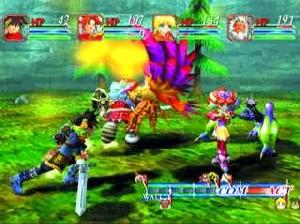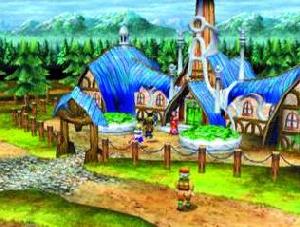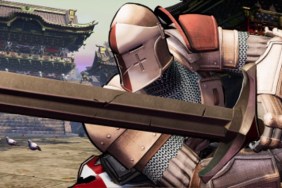Definitely grand.
The dark side is indeed a dangerous path to walk down. Fear
leads to anger, anger leads to hate, hate leads to suffering… and suffering means
that a lot of bad guys are running around causing everyone to have a really bad
day. Only a hero of the Light can save the people and often, that hero comes from
a most unlikely place.
Grandia II is next up in the growing lineup of Dreamcast RPGs. Following
Sega’s stellar Skies of Arcadia, GII
has its work cut out for it. It’s a good thing Ubi Soft has learned a thing
or two about choosing which RPGs to publish. This is one sweet game.
Our hero of the day just happens to be a “scum of the earth” mercenary named
Ryudo. He’s deadly, he’s dangerous, and he’s got that little soft spot for helpless
innocents. In short, he’s the perfect hero. The main cast also includes Elena,
the songstress with the Jeckyl and Hyde complex, Roan, the boy wonder, and Mareg,
the man-beast who is apparently the only character who has a nose. Pretty interesting
group of characters for misadventures in a distant land.
So a long time ago, Granas, the God of Light, lays the smack down on Valmar,
the God of Darkness (not to be confused with GR founder Duke Ferris, the Lord
of Darkness). Of course, Valmar wasn’t destroyed (only a bit dismembered), so
he’s been a busy little bee over the last few millennia and has almost gained
enough power to put himself back together. Ryudo takes on a job guarding Elena
the choir girl in a ceremony to strengthen the seal holding the Dark god. From
there, all hell breaks loose and our characters are drawn into the eternal battle
between the good, the bad, and the ugly. While the story is far from original,
it is solid enough to hold all of Grandia II’s strong points together.
The sugar naturally starts off with high-powered graphics. The smooth cartoony
characters look great against a colorful world. On top of this, you’ve got CGI
cutscenes and an extra special surprise waiting for you in the spell department.
Some of the special moves/spells are the best I’ve ever seen in an RPG and you
won’t even have to play for days before you get to see one. There are even a
few super moves (Millenia’s Fallen Wings, for example) that feature an actual
animated cutscene interspersed over the live action. Wow!
Ubi Soft’s first Dreamcast RPG, Evolution, featured
visible enemies throughout the world. Grandia II also sports the same
system, allowing players to see what’s in store for them. Since enemies are
visible, players can also add the element of surprise to their attack by sneaking
in from the rear. They can also be avoided if you’re looking to get somewhere
quick.
Grandia II’s strongest flavor, however, can be found within its ingenious
combat system. Rather then settling for the classic turn-based ingredients that
most RPGs rely upon, GII throws a nice dose of action into the mix. An
icon is displayed for each combatant on the timeline. Each character’s stats
determine how fast his/her/it’s icon travels along the timeline. When the “Command”
point is reached, the battle pauses and you input your attacks and spells. When
your icon reaches the “Act” point, the move is carried out. So instead of the
slower-paced battle of an average turn-based conflict, players get an uptempo
free-for-all that definitely requires strategy and awareness.
 Strategy,
Strategy,
you ask? Yep. Critical attacks (among other things) can increase enemies’ wait
time. It gets even better if the counter is executed between enemies’ command
and act points. You’ve also got to consider a character’s distance to the target
and speed.
In addition, you can choose to initialize character (or party) AI and let
the computer take control of things. So if you feel like being really lazy or
if a, ahem, foreign substance is sucking brain cells from your cranium, just
select a battle strategy and kick back! Your characters will handle things all
by themselves. If something goes horribly wrong, you have the option to jump
into the fray and take matters back into your own hands.
With all these things to consider during combat, Grandia II’s battle
system has much more to offer than the average slow plodding RPG. This much
action in an RPG is so addictive should be illegal in the U.S. (and parts of
Canada).
One cool little touch is the inclusion of voice acting. While it only appears
in clumps, it’s nice to be able to sit back and listen to a conversation rather
than having to read text all the time. And speaking of text…
There seems to be something weird going on with the text scroll speed. It’s
almost as if there are occasional hiccups as the text appears. It’s not a big
problem, but if you’re a fast reader, these pauses will make you feel as if
you are reading a script from a badly dubbed Chinese
kung-fu movie.
You’ll find another small difficulty as you travel through the different lands.
While the layout of the realms is fine, you’ll probably find yourself wishing
for a map. A compass is located on screen, but a map would have been much more
helpful. This could definitely be a big problem for anyone with a
very bad sense of direction.
But these are minor flaws. Grandia II adds a stellar volume to the
Dreamcast’s growing library of RPGs. High-quality graphics along with a new
action doused combat system that’s bound together with a solid story make for
one hell of a game.

-
Outstanding graphics
-
Cool spells
-
Interesting battle system
-
Dismembered God of Darkness
-
Could use a map







